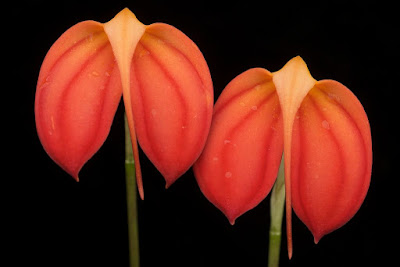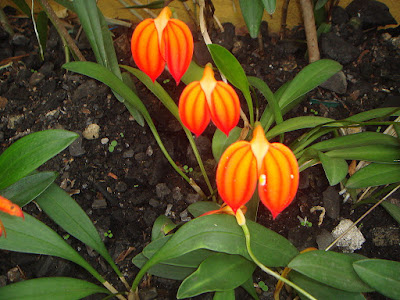Masdevallia ignea is endemic to Colombia. First collected from the Eastern Cordillera of Colombia in 1879 and imported by Messrs. Low and Company, the original collector and locality are unknown. The species has been subsequently found growing luxuriantly as a terrestrial at elevations of 3000 to 3130 m in the rich humus of tall forests of the Department of Norte de Santander and in the forest below Páramo de Jurisdicciones in Colombia.
Masdevallia ignea also called as The Fire-Red Masdevallia, Masdevallia boddaertii, Masdevallia ignea f. citrina, Masdevallia ignea var. armeniaca, Masdevallia ignea var. aurantiaca, Masdevallia ignea var. boddaertii, Masdevallia ignea var. citrina, Masdevallia ignea var. coccinea, Masdevallia ignea var. goorii, Masdevallia ignea var. grandiflora, Masdevallia ignea var. hobartii, Masdevallia ignea var. marschalliana, Masdevallia ignea var. massangeana, Masdevallia ignea var. pulchra, Masdevallia ignea var. rubescens, Masdevallia ignea var. splendens, Masdevallia ignea var. stobartiana, Masdevallia ignea var. superba, Masdevallia ignea var. tomasonii, Masdevallia ignea var. vuylstekeana, is a species of the genus Masdevallia. This species was described by Heinrich Gustav Reichenbach in 1871. The species epithet is derived from the Latin word igneus, meaning fire-red, and refers to the striking color of the flower of this showy species.
IDENTIFY MASDEVALLIA IGNEA ORCHID PLANT
Masdevallia ignea is endemic to Colombia. First collected from the Eastern Cordillera of Colombia in 1879 and imported by Messrs. Low and Company, the original collector and locality are unknown. The species has been subsequently found growing luxuriantly as a terrestrial at elevations of 3000 to 3130 m in the rich humus of tall forests of the Department of Norte de Santander and in the forest below Páramo de Jurisdicciones in Colombia.
It is a small sized, cold growing terrestrial orchid with stout, erect, ramicauls enveloped basally by 2 to 3 loose, tubular sheaths and carrying sub erect, elliptic-lanceolate to oblong-lanceolate, coriaceous, dark green leaf that is narrowly cuneate below into the sulcate petiole.
The Fire-Red Masdevallia blooms in late spring and summer from a single flowered, erect, slender, terete, 30 to 37.5 cm long inflorescence holding the flower well above the leaves. After its initial discovery, it became an immediate horticultural favorite, and collectors were sent to find color variations. The colors include yellow-red, oranges, red and red-oranges, with varying degrees of pink to purple suffusion. The flower size is also quite variable, but the species is readily distinguished by the tail of the dorsal sepal that curves downward between the lateral sepals.
MASDEVALLIA IGNEA ORCHID PLANT CARE AND CULTURE
Cultural information should only be used as a guide, and should be to be adapted to suit you. Your physical location; where you grow your plants, how much time you have to devote to their care, and many other factors, will need to be taken into account. Only then can you decide on the cultural methods that best suit you and your plants.
Light:
Masdevallia ignea like good light, but not direct light. 17000 - 22000 lux is a good amount of light. About 70-90% shade is recommended in summer and 25% shade to full sun in winter. It will flower better if receive plenty of light and leaves are pale green rather than dark green when in heavy shade.
Temperature:
The Fire-Red Masdevallia like cool growing conditions from 5°C to 25°C. Ideally in winter they like a minimum of 10°C in and a maximum of 13°C. In summer the optimum range is 13 to 20°C. The temperature should not exceed 25°C and temperatures consistently above 30°C will weaken the plants and they may drop their leaves. Ensure 6-12°C day/night difference to aid flower formation.
Humidity:
This orchid prefer high humidity in summer near 75-80% and may need a humidifier over summer. Keep air circulation at all times to prevent water staying on leaves as this will encourage leaf spot.
Substrate, growing media and repotting:
Masdevallia ignea can be grown in basket or net pots. They can also be grown in pots or mounted. They prefer a continuously damp medium. Some growers use chopped sphagnum moss mixed with polystyrene chips. Others use a pine bark, polystyrene and coarse perlite mix. A mix of 5 parts bark, 5 parts perlite and 1 part fibrous, not fine, peat moss is recommended. Their roots are small and many and will fill pots very quickly when growing well. Deeper pots are generally used and plants are potted out from being divided into 5cm tubes, 7-10cm pots or 12-15cm pots depending on size.
Repot or divide the plants during the autumn or spring every two years or when they are sufficiently large enough. It is best, as with most plants, to repot when the plants are about to root to minimize disturbance. Huge clumps must be divided as a considerable number of species tend to completely rot from the oldest parts of the clump. Do not bury the base of the plants. Double potting is beneficial to keep the plant roots cool.
Watering:
The Fire-Red Masdevallia will not tolerate dry conditions and should be kept moist but not soggy. Their roots must be able to dry out slightly between waterings. In hot weather they need daily watering but in spring and autumn weekly watering should suffice. Water in the morning so leaves can be dry by midday. The plants should be provided with rain water or distilled water or a very pure water source. It is preferable to provide a humid environment than keeping roots too wet as they are prone to rotting.
Fertilizer:
Masdevallia ignea are generally active throughout the year although growth may be slower in winter. Use a balanced fertiliser at 1/4 strength throughout the year; feed at every third or fourth watering. If in doubt do not feed. These plants do not like salt so roots will easily turn brown if over fed. If plants need a boost then a dilute foliar feed can be applied. Higher feeding schedules can be used if the grower masters their culture perfectly well. Do not use lime or dolomite lime.















COMMENTS